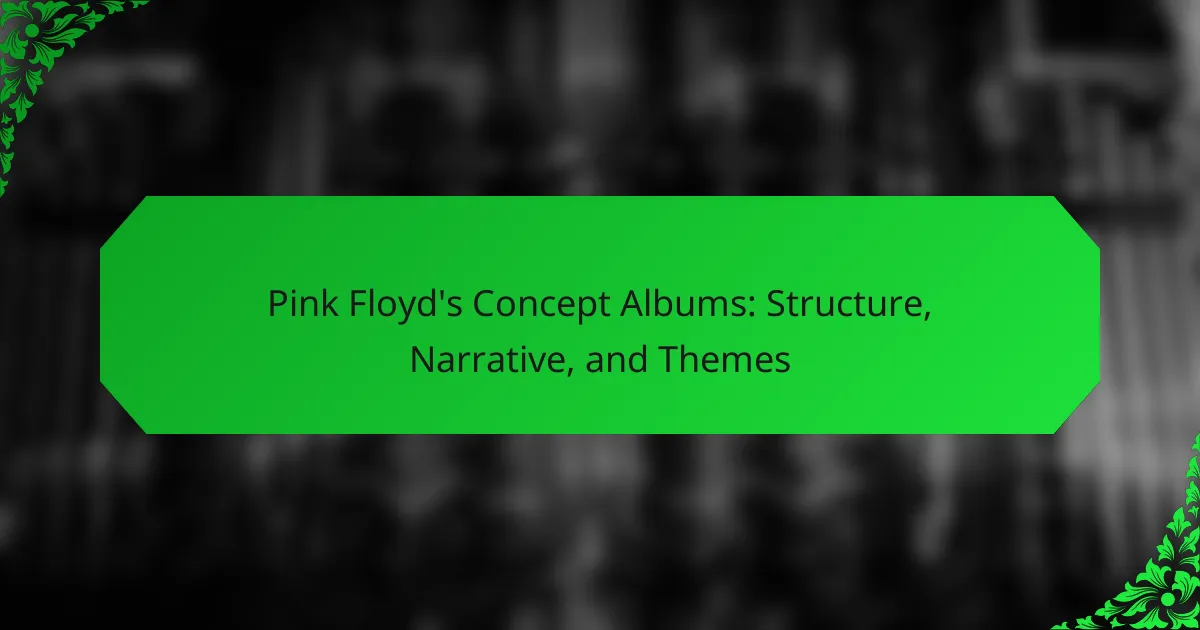Pink Floyd’s concept albums, such as “The Dark Side of the Moon” and “The Wall,” are recognized for their cohesive narratives and thematic depth. These albums explore complex topics like mental health, existentialism, and alienation, characterized by intricate storytelling and innovative soundscapes. Pink Floyd’s unique integration of music and narrative, along with their use of sound effects and seamless transitions, has transformed the perception of albums as an art form. Their pioneering approach has influenced a wide range of artists across various genres, establishing a lasting legacy in the music industry and popular culture.

What are Pink Floyd’s Concept Albums?
Pink Floyd’s concept albums are cohesive works that explore a unified theme or narrative throughout their tracks. Notable examples include “The Dark Side of the Moon,” which delves into mental health and existentialism. “The Wall” narrates the story of a rock star’s isolation and alienation. These albums are characterized by their intricate storytelling, musical transitions, and thematic depth. The band often used sound effects and orchestration to enhance the narrative experience. “The Dark Side of the Moon” remains one of the best-selling albums of all time, illustrating the impact of their concept-driven approach. Pink Floyd’s innovative use of music and lyrics set a precedent for future concept albums in rock music.
How did Pink Floyd’s concept albums evolve over time?
Pink Floyd’s concept albums evolved significantly from their early works to later masterpieces. Initially, their albums like “The Piper at the Gates of Dawn” featured abstract themes and experimental sounds. With “The Dark Side of the Moon,” released in 1973, they introduced cohesive narratives and themes of mental health and societal issues. This album’s commercial success solidified their approach to concept albums.
Subsequent albums, such as “Wish You Were Here” and “Animals,” continued to explore complex themes, reflecting social commentary and personal loss. “The Wall,” released in 1979, marked a peak in narrative depth, presenting a rock opera format that addressed isolation and trauma.
The evolution culminated in “The Final Cut,” which focused on war and loss, showcasing a more poignant and political tone. Each album demonstrated a progression in storytelling, musical complexity, and thematic depth, solidifying Pink Floyd’s legacy in the realm of concept albums.
What are the defining features of a concept album?
A concept album is a musical work that tells a cohesive story or explores a unified theme. It typically consists of interconnected songs that contribute to a larger narrative. The songs may vary in style but are linked by lyrical content or musical motifs. Concept albums often include recurring characters or storylines, enhancing the listening experience. They encourage listeners to engage with the album as a whole rather than as individual tracks. Notable examples include Pink Floyd’s “The Wall,” which addresses themes of isolation and societal issues. This format has been influential in the development of modern music, shaping how artists approach storytelling in their work.
How do Pink Floyd’s albums fit the concept album definition?
Pink Floyd’s albums fit the concept album definition through their unified themes and narratives. Each album tells a cohesive story that explores complex ideas. For instance, “The Dark Side of the Moon” addresses mental health and existentialism. The tracks are interconnected, creating a seamless listening experience. Similarly, “The Wall” narrates the life of a character named Pink, exploring isolation and loss. The use of recurring musical motifs further enhances this narrative continuity. Additionally, the albums often include sound effects and spoken word segments that contribute to the overall theme. This intentional structure aligns with the characteristics of concept albums.
What themes are prevalent in Pink Floyd’s concept albums?
Prevalent themes in Pink Floyd’s concept albums include alienation, mental illness, and existentialism. Alienation is depicted in albums like “The Wall,” where isolation from society is a central focus. Mental illness is explored through “The Dark Side of the Moon,” highlighting the struggles of the mind. Existentialism is evident in “Wish You Were Here,” reflecting on absence and the search for meaning. Additionally, critiques of war and capitalism appear in “Animals,” showcasing societal issues. These themes are consistently interwoven, creating a profound narrative throughout their discography.
How do these themes reflect the band’s artistic vision?
The themes in Pink Floyd’s concept albums reflect the band’s artistic vision by exploring complex human emotions and societal issues. Their work often addresses themes of alienation, mental illness, and the passage of time. For example, “The Wall” delves into the psychological struggles of isolation and trauma. This album’s narrative structure showcases the protagonist’s descent into madness, illustrating the band’s focus on personal and collective experiences. Additionally, “Dark Side of the Moon” examines the pressures of life, including conflict and the inevitability of death. The seamless integration of music and lyrics in these albums reinforces their thematic depth. Pink Floyd’s artistic vision is rooted in creating immersive experiences that provoke thought and reflection.
What are the common motifs found in their lyrics?
Common motifs found in Pink Floyd’s lyrics include alienation, existentialism, and the passage of time. Alienation is often depicted through themes of isolation and disconnection from society. Existentialism explores the search for meaning in an indifferent universe. The passage of time is frequently represented by reflections on mortality and the fleeting nature of life. These motifs are evident in albums like “The Dark Side of the Moon” and “The Wall.” The band’s use of surreal imagery and introspective narratives reinforces these themes throughout their discography.
What is the narrative structure of Pink Floyd’s concept albums?
Pink Floyd’s concept albums typically feature a linear narrative structure. This structure often revolves around a central theme or story that unfolds throughout the album. Each song acts as a chapter, contributing to the overall narrative arc. For example, “The Wall” tells the story of a character’s psychological struggles and isolation.
The narrative often includes recurring motifs and musical themes that link the tracks. This cohesiveness enhances the storytelling experience. Additionally, the albums frequently explore complex themes such as alienation, war, and mental health. The use of sound effects and spoken word segments further enriches the narrative.
Overall, Pink Floyd’s concept albums create immersive experiences that engage listeners through their intricate storytelling and thematic depth.
How do the narratives interconnect across different albums?
The narratives across Pink Floyd’s albums interconnect through recurring themes and motifs. Common elements include the exploration of existentialism, alienation, and the human condition. For instance, “The Wall” delves into personal trauma, while “Animals” critiques societal structures. Both albums illustrate the struggle against oppressive forces. The character of Pink from “The Wall” embodies themes of isolation found in earlier works. Additionally, musical motifs, such as the use of sound effects, create continuity. Lyrics often reference previous albums, reinforcing connections. This interconnectedness enriches the overall narrative experience across their discography.
What storytelling techniques does Pink Floyd employ?
Pink Floyd employs various storytelling techniques in their music. They use concept albums to create cohesive narratives. Each album often explores themes of alienation, mental health, and societal issues. Musical motifs and recurring characters enhance the storytelling experience. The use of sound effects adds depth to the narrative. Lyrics often serve as poetic reflections of the overarching themes. Visual elements in concerts and album art further enrich the storytelling. These techniques culminate in a unique auditory and visual experience for the audience.
How do musical elements contribute to the concept album experience?
Musical elements enhance the concept album experience by creating a cohesive narrative. They establish thematic continuity through recurring motifs and harmonies. For instance, Pink Floyd employs specific chord progressions to evoke emotions aligned with their lyrics. This technique reinforces the storytelling aspect of their albums. Additionally, transitions between tracks often utilize sound effects or musical bridges. These elements maintain flow and immersion, preventing disconnection between songs. The use of dynamics and instrumentation also contributes to the atmosphere. For example, varying tempo and volume can reflect the emotional journey of the album. Overall, musical elements are integral in shaping the listener’s experience and understanding of the concept.
What role do instrumentation and arrangements play in conveying themes?
Instrumentation and arrangements are crucial in conveying themes in Pink Floyd’s concept albums. They create emotional landscapes that enhance lyrical content. For instance, the use of synthesizers in “Wish You Were Here” evokes feelings of nostalgia and loss. Similarly, orchestral arrangements in “The Wall” underscore themes of isolation and despair. The dynamics of instrumentation can shift from soft melodies to intense crescendos, reflecting the emotional journey of the narrative. Each instrument contributes to the overall atmosphere, reinforcing the album’s message. This synergy between music and theme is a hallmark of Pink Floyd’s artistry, making their albums resonate deeply with listeners.
How does the production style enhance the narrative?
The production style of Pink Floyd enhances the narrative by creating immersive soundscapes. This style incorporates innovative studio techniques and sound effects. For example, the use of stereo panning draws listeners into the music. Layered instrumentation provides depth and complexity to the storytelling. Vocals are often treated with effects to convey emotion. This technique helps to express the themes of isolation and existentialism. The seamless transitions between tracks maintain narrative continuity. Overall, the production style complements the lyrical content and thematic elements effectively.
What are the critical receptions of Pink Floyd’s concept albums?
Pink Floyd’s concept albums received widespread critical acclaim. Albums like “The Dark Side of the Moon” and “The Wall” are often hailed as masterpieces. Critics praised their innovative soundscapes and deep lyrical themes. “The Dark Side of the Moon” is noted for its exploration of mental health and existentialism. It spent 741 weeks on the Billboard 200 chart, highlighting its lasting impact. “The Wall” was recognized for its narrative structure and emotional depth. Many reviews highlighted its commentary on isolation and societal issues. Overall, Pink Floyd’s concept albums are considered pivotal in rock music history.
How have critics interpreted the themes and narratives?
Critics have interpreted the themes and narratives of Pink Floyd’s concept albums as profound explorations of human experience. They often highlight the recurring themes of alienation, mental illness, and the passage of time. For instance, “The Wall” is seen as a commentary on isolation and the impact of fame. Critics note that the narrative structure often mirrors the psychological struggles of the characters. The use of surreal imagery and soundscapes enhances the emotional depth of the narratives. In “Dark Side of the Moon,” themes of mortality and existentialism are prevalent. Critics emphasize how these themes resonate universally, making the albums timeless. Overall, the interpretations reflect a deep engagement with the psychological and societal issues presented in the music.
What impact have these albums had on the music industry?
Pink Floyd’s concept albums have significantly influenced the music industry by redefining artistic expression in rock music. Their work, particularly “The Dark Side of the Moon,” introduced the concept of albums as cohesive narratives rather than just collections of songs. This shift encouraged artists to explore deeper themes and storytelling within their music.
The band’s innovative use of studio technology set new production standards, inspiring future generations of musicians. Their albums also contributed to the rise of progressive rock, which emphasized complex compositions and lyrical depth.
Moreover, Pink Floyd’s emphasis on live performances and visual artistry transformed concert experiences, influencing how music is presented. The commercial success of their albums demonstrated the viability of ambitious and experimental projects in the mainstream market.
Overall, Pink Floyd’s concept albums have left an enduring legacy, shaping the direction of modern music and the expectations of both artists and audiences.

How do Pink Floyd’s Concept Albums Compare to Other Artists?
Pink Floyd’s concept albums are distinguished by their cohesive narratives and thematic depth. Unlike many artists, Pink Floyd integrates music and storytelling seamlessly. Their albums, such as “The Wall” and “Dark Side of the Moon,” explore complex psychological and social themes. These works often feature recurring motifs and characters, enhancing the overall experience. In contrast, other artists may focus on individual songs without a unifying story. For example, The Who’s “Tommy” is a notable concept album, but it lacks the same level of intricate soundscapes. Pink Floyd’s use of sound effects and innovative production techniques further sets them apart. Their albums often evoke specific emotions, drawing listeners into a profound auditory journey. This unique approach has influenced numerous artists across genres, establishing Pink Floyd as pioneers in the realm of concept albums.
What similarities exist between Pink Floyd and other concept album artists?
Pink Floyd shares several similarities with other concept album artists. Both Pink Floyd and these artists often explore complex themes through their music. They utilize a continuous narrative that connects individual tracks into a cohesive story. This approach enhances the overall listening experience. Additionally, they incorporate innovative soundscapes and production techniques. This experimentation creates immersive environments for the audience. Artists like The Who and Genesis also use elaborate storytelling in their albums. Such narratives often reflect personal or societal issues, similar to Pink Floyd’s focus on alienation and mental health. Overall, these artists contribute to the evolution of the concept album format.
How do their themes and narratives differ from those of other bands?
Pink Floyd’s themes and narratives differ from those of other bands through their deep exploration of existentialism and human experience. Their concept albums often focus on complex emotional and psychological issues. For example, “The Wall” addresses themes of isolation and mental breakdown. This contrasts with many bands that prioritize more straightforward love or party themes. Additionally, Pink Floyd employs cinematic storytelling techniques in their music. Their use of soundscapes and progressive structures enhances narrative depth. This approach allows listeners to engage with the music on multiple levels. Their philosophical lyrics set them apart from typical rock narratives. Overall, Pink Floyd’s unique thematic focus and innovative narrative style distinguish them in the music landscape.
What unique attributes set Pink Floyd apart in the concept album genre?
Pink Floyd is distinguished in the concept album genre by their innovative use of soundscapes and thematic depth. Their albums often explore complex themes such as alienation, mental illness, and societal critique. “The Dark Side of the Moon,” released in 1973, is a prime example, addressing the pressures of modern life. The seamless transitions between tracks create a cohesive listening experience. Additionally, their incorporation of spoken word and sound effects enhances the narrative quality of their music. The use of visual elements in live performances further sets them apart. This combination of audio and visual storytelling has influenced many artists in the genre. Pink Floyd’s ability to blend progressive rock with philosophical concepts remains unparalleled.
What influences did Pink Floyd draw upon for their concept albums?
Pink Floyd drew upon various influences for their concept albums. Their music was shaped by literature, film, and personal experiences. George Orwell’s “1984” inspired themes in “Animals.” The band’s exploration of mental health was influenced by Syd Barrett’s struggles. Additionally, they incorporated philosophical ideas, particularly existentialism. The visual arts also played a significant role, especially in the album design. Their use of soundscapes was influenced by avant-garde composers. These diverse sources contributed to the depth and complexity of their concept albums.
How did cultural and societal factors shape their music?
Cultural and societal factors significantly shaped Pink Floyd’s music. The band’s work reflected the political climate of the 1960s and 1970s. Issues such as war, mental health, and societal alienation influenced their themes. The counterculture movement provided a backdrop for their exploration of existential questions. Events like the Vietnam War and the rise of consumerism are evident in their lyrics. The band’s use of innovative soundscapes mirrored the technological advancements of the time. Their music served as a critique of societal norms and expectations. Pink Floyd’s albums often addressed the disillusionment felt by many during that era. This connection to cultural and societal factors made their music resonate deeply with audiences.
What literary and artistic influences can be identified?
Pink Floyd’s concept albums exhibit influences from various literary and artistic sources. Notable literary influences include George Orwell’s “1984,” which inspired themes of dystopia and societal control in “The Wall.” The band’s lyrics often reflect existentialism, drawing from the works of authors like Albert Camus and Franz Kafka.
Artistically, Pink Floyd was influenced by surrealism and abstract art, evident in their album cover designs by Storm Thorgerson. The visual elements in their performances also echo the works of artists such as Salvador Dalí. Additionally, the band incorporated cinematic techniques, influenced by filmmakers like Federico Fellini.
These influences helped shape the narrative depth and thematic complexity of their albums, creating a rich tapestry of sound and meaning.

What are the lasting impacts of Pink Floyd’s Concept Albums?
Pink Floyd’s concept albums have significantly influenced the music industry and popular culture. Their use of thematic storytelling transformed how albums are perceived. The albums, such as “The Dark Side of the Moon” and “The Wall,” introduced cohesive narratives that resonated with listeners. These works explore complex themes like mental health, war, and existentialism. This approach has inspired countless artists across various genres to create albums with similar narrative structures. Pink Floyd’s innovative soundscapes and production techniques also set new standards in music production. Their albums often feature seamless transitions between tracks, enhancing the listening experience. This has led to a greater appreciation for the album format as an art form. Overall, Pink Floyd’s concept albums have left a lasting legacy on music, influencing both artists and audiences alike.
How have Pink Floyd’s concept albums influenced modern music?
Pink Floyd’s concept albums have significantly influenced modern music by shaping the structure and narrative of albums. Their work, particularly “The Dark Side of the Moon” and “The Wall,” introduced cohesive storytelling in music. This approach has inspired contemporary artists to create albums with thematic continuity. Many modern musicians adopt similar narrative techniques, integrating personal and social commentary. For example, artists like Kendrick Lamar and Radiohead have utilized concept album formats. They explore complex themes, echoing Pink Floyd’s influence. The use of soundscapes and sonic experimentation in their albums has also set a precedent for modern production techniques. Overall, Pink Floyd’s innovative approach continues to resonate in today’s music landscape.
What contemporary artists cite Pink Floyd as an influence?
Contemporary artists who cite Pink Floyd as an influence include Radiohead, Tame Impala, and The 1975. Radiohead’s album “OK Computer” reflects themes similar to Pink Floyd’s work, particularly in its exploration of alienation. Tame Impala’s psychedelic sound is reminiscent of Pink Floyd’s musical style. The 1975 has mentioned Pink Floyd’s impact on their music, especially in terms of conceptual album structure. These artists acknowledge Pink Floyd’s contribution to the evolution of rock music and concept albums. Their influences can be seen in lyrical themes and sonic experimentation.
How do modern concept albums reflect Pink Floyd’s legacy?
Modern concept albums reflect Pink Floyd’s legacy through their thematic depth and narrative cohesion. Many contemporary artists adopt ambitious storytelling techniques similar to Pink Floyd’s. For instance, albums like “The Wall” and “Dark Side of the Moon” explore complex emotional landscapes. Modern albums often tackle similar existential themes, showcasing a blend of music and narrative. Artists like Kendrick Lamar and Tool have created albums that echo this approach. They use intricate compositions to enhance storytelling, much like Pink Floyd did. The influence of Pink Floyd is evident in the use of soundscapes and atmospheric elements. Overall, modern concept albums continue to honor Pink Floyd’s innovative spirit and artistic vision.
What can listeners learn from Pink Floyd’s approach to concept albums?
Listeners can learn about the integration of narrative and music from Pink Floyd’s approach to concept albums. Pink Floyd’s albums often tell cohesive stories that explore complex themes. For example, “The Wall” addresses isolation and mental health through its narrative structure. This album features interconnected tracks that enhance the storytelling experience. Additionally, listeners can appreciate the use of soundscapes and instrumentation to evoke emotions. The band’s innovative production techniques create immersive listening experiences. Their work illustrates the potential of music as a medium for deep thematic exploration. Overall, Pink Floyd’s concept albums exemplify how music can combine narrative depth with artistic expression.
How can understanding their narratives enhance the listening experience?
Understanding the narratives of Pink Floyd’s concept albums enhances the listening experience by providing context and deeper meaning. The narratives often explore complex themes such as alienation, mental health, and societal issues. Engaging with these stories allows listeners to connect emotionally with the music. It also encourages active listening, as fans seek to interpret the lyrics and soundscapes. For example, “The Wall” tells a story of personal struggle and isolation. Recognizing this narrative can evoke empathy and introspection in listeners. Studies show that narrative engagement can increase emotional responses to music. This connection ultimately leads to a more immersive and rewarding listening experience.
What techniques can aspiring musicians adopt from Pink Floyd’s work?
Aspiring musicians can adopt several techniques from Pink Floyd’s work. They can focus on creating concept albums that tell a cohesive story. Pink Floyd’s albums often feature thematic continuity, which engages listeners on a deeper level. Musicians can also experiment with soundscapes and atmospheric elements. This approach enhances emotional impact and creates immersive experiences.
Additionally, they should consider the use of progressive structures in their compositions. Pink Floyd often blended various musical styles and genres, showcasing versatility. Incorporating instrumental sections can allow for exploration and development of ideas. Finally, musicians can draw inspiration from their lyrical depth, addressing complex themes such as existentialism and human experience. These techniques can help aspiring artists develop unique and impactful music.
The main entity of the article is Pink Floyd’s concept albums, which are cohesive musical works that explore unified themes and narratives. The article examines the evolution of these albums, highlighting key examples such as “The Dark Side of the Moon” and “The Wall,” and discusses their defining features, prevalent themes, and narrative structures. It also analyzes how musical elements, production styles, and storytelling techniques contribute to the overall experience of the albums. Additionally, the article explores the impact of Pink Floyd’s concept albums on the music industry and their influence on contemporary artists and modern concept albums.
